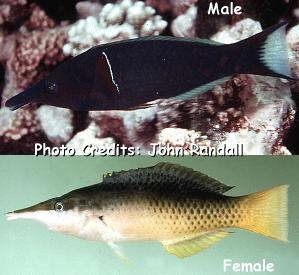
By Bob Goemans

Not Reef Tank Suitable
Likely Fish-Only Tank Suitable
Range: Indian Ocean: East Africa south to Natal South Africa, and east to the Andaman Sea.
Size: 12 inches (30 cm)
Natural Environment: Inhabits coral rich areas of lagoons and seaward reefs and usually found at depths between 3 – 100 feet (1– 30 m) where it feeds on smaller fishes and crustaceans.
General Husbandry: Occasionally seen in the trade with the male a very dark overall green with white on the trail edge of the tail, with females a black back and yellowish white belly and tail.
Best maintained in fish-only aquariums having a fine sand bed, (0.5 – 2.0 mm) and at least 4 inches deep, along with several rocky crevices to hunt and also open swimming areas. Those in this genus will not only rearrange bottom dwelling corals in its search for tasty bottom dwelling invertebrates, as it will eat smaller fishes, snails, tubeworms, sea stars, cucumbers, urchins, crabs, shrimp and stick its long snout into open clams to feed on its meaty interior, it will also quickly burrow into the sand bed if frightened. Yet usually sleep under rock shelves, on or under a coral branch, in a crevice, or directly on the sand surface.
The very real possibility of it diving into the sand bed, which will cause clouds of sand particles to be dispensed into the water, would cause various corals harm. Therefore, those in this genus are not recommended for reef aquariums.
As to diet, products such as marine fish and crustacean flesh, clams, and other marine meaty foods should make up the majority of their diet and be enriched and chopped into fine pieces and fed twice daily.
Taxonomy:
Order: Perciformes
Suborder: Labroidei
Family: Labridae
Genus: Gomphosus
FYI: Hardy, however, almost always moving and a difficult fish to adequately feed. Can cause stress to its tankmates.
The aquarium should have small pieces of rocks for the wrasse to ‘play’ with in its daily search for prey.
Can greatly stir bottom sandbeds creating large clouds of sand being dispensed in many directions.
One male per aquarium, however, should a female and male be desired, the female should be introduced first unless both are being introduced at the same time.
If a female is introduced and maintained without a male, it will turn into a male.
Similar species found in the Indian Ocean - G. varius.
Experience Level: Intermediate
Temperament: Semi-aggressive
Diet: Carnivore
Coral Safe: Yes
Fish Safe: With caution
Invertebrate Safe: With caution
Acclimation Time: 30 minutes+
Aquarium Environment: Fish-only aquarium
Tankmates: Larger, active and moderately aggressive
Minimum Tank Size: 100 gallons
Temperature Range: 74 - 82°F (23 – 27°C)
Specific Gravity: 1.020 - 1.026
pH: 8.0 - 8.5
